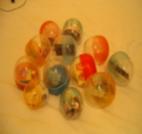|
July 2008
The Elements of Manga are a creation of cultural differences. If this is apparent from the last columns I don't know what is. The way manga is sold, the way it is made, the artists involved, and how they become involved; all of these arise from the cultural differences unique to Japan. All of the elements I've discussed so far are quite different from American publication, so another difference is the merchandising of manga, beyond just the publication and the advertising of manga. Tie-in's are a huge part of the elements of manga.
The production of manga is very different from American comics on so many levels, many of which we've discussed. The amount of people involved is about the same, but their roles are what are so moved around. First, a manga creator usually plots and draws his manga himself, similar to plot-style comic book creation, or a writer/artist does (Jack Kirby, Scott McCloud, Todd McFarlane, Dan Jurgens, etc.). The creator also usually scripts the series himself. From here though is where differences come into play. Most manga creators, or manga-ka, have assistants. While this has begun to happen with some American creators (with disastrous results ala Pat Lee) most artists sit down and draw everything and then have an inker finish it. A manga-ka has a variety of ways they will approach this. Some draw everything and have assistants ink or revise the drawings a bit. Some draw the characters and have assistants draw the backgrounds. Some just beg to have assistants so that their manga has a hope of coming out on time! (Kouta Hirano the creator of Hellsing would be the biggest example of this . . . ) At this point then a colorist may be brought in to color a few pages for publication in the major magazines, and of course there is an editor who will oversee all of this, just like any publication.
A big difference here though is that in almost all instances a property is owned by the creator. Dragonball Z is owned by Akira Toriyama, Ranma ½, Maison Ikkoku, Inu-Yasha, and more are all owned by Rumiko Takahashi. In some cases, like Death Note, where a writer and artist are involved both own the property, but unlike American comics the creator owns the property and they make most of the merchandising money. So what does this mean? Well most times . . . if a manga becomes popular then you will see those characters and that artist's artwork on tons
|

